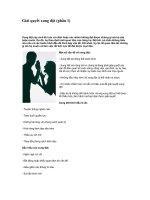Kỹ năng giải quyết xung đột
Bạn đang xem bản rút gọn của tài liệu. Xem và tải ngay bản đầy đủ của tài liệu tại đây (356.75 KB, 26 trang )
Understanding and Resolving
Conflict
Mark Smallwood
Brigham Young University
Agenda
•
What is conflict?
•
What is conflict’s role in business?
•
Different views of conflict
•
Kinds of conflict
•
Stages of conflict resolution
•
Methods of conflict resolution
•
Group Exercise
•
Review
What is Conflict?
A process that begins when one party perceives that another party has negatively affected, or
is about to negatively affect, something that the first party cares about.
A Few Questions
•
Is conflict bad for business?
•
What kind of conflict is seen in our
business?
•
Does this conflict help or hurt our
performance?
Conflicts About Conflict’s Role
•
Different Views
–
Traditional View
–
Human Relations View
–
Interactionist View
Different Views
•
Traditional View
–
Conflict is bad!
–
Same as violence, destruction, irrationality
Different Views
•
Human Relations View
–
It’s going to happen, so cope with it!
Different Views
•
Interactionist View
–
Functional conflict is good for business and
even encouraged
–
Functional vs. dysfunctional conflict
Kinds of Conflict
•
Task Conflict
–
Low to moderate levels can be acceptable
•
Process Conflict
–
Low levels can be acceptable
•
Relationship Conflict
–
Almost always dysfunctional
The Conflict Process
•
Four Stages
–
Potential opposition
–
Cognition and personalization
–
Behavior
–
Outcomes
The Conflict Process
•
Stage 1
–
Potential Opposition
•
Factors are present that can lead to conflict
–
Communication
–
Structure
–
Personal Variables
The Conflict Process
•
Stage 2
–
Cognition and Personalization
•
Awareness of conditions in stage 1
•
The conditions cause some sort of frustration
The Conflict Process
•
Stage 3
–
Behavior
•
An action is done that frustrates another person’s
interests
•
The conflict becomes known to the differing parties
and to others
The Conflict Process
•
Stage 4
–
Outcomes
•
Functional Outcomes
•
Dysfunctional Outcomes
Conflict Resolution
•
Even in the interactionist view of conflict, conflict can become dysfunctional.
•
At this point, someone may need to step in and help resolve the conflict.
Methods for Resolving Conflict
•
Passive conflict resolution
•
Win-win
•
Structured problem solving
•
Confronting conflict
•
Choosing a winner
•
Selecting a better alternative
•
Preventing Conflict
Methods for Resolving Conflict
•
Passive conflict resolution
–
Just ignore the conflict
•
Win-win
–
Satisfy both side’s needs
Methods for Resolving Conflict
•
Structured problem solving
–
Gather data about the problem
–
Have a third party observer analyze the data
and make an argument for one side
–
Mediation
•
Confronting conflict
–
Listen the problem and help the parties resolve
it
Methods for Resolving Conflict
•
Choosing a winner
–
Choose the winner, then deal with the negative
feelings between the two parties
•
Selecting a better alternative
–
Choose an idea neither of the parties considered
Methods for Resolving Conflict
•
Preventing conflict
–
“Skilled leaders use different techniques to
create an environment that is relatively free of
conflict…” (Foster)
Shea & Gould Law Firm
•
“At its peak, the firm had 350 lawyers and played a leading role in New York politics,
banking, real estate and sports”
•
Closed its doors after not being able to resolve a conflict about the firms future
Let’s Try These Out!
•
Split up in groups of three people
•
Choose a conflict that could be faced in this organization
•
Discuss how it would be handled using each of the methods listed previously
Let’s Try These Out!
•
Describe your conflict
•
What method would be best for handling your chosen situation?
•
Would that method be best for all situations in this organization?
•
What does everyone else think?
Summary
•
Conflict can be good for a business
•
When it isn’t good, the conflict must be resolved
•
Different methods exist to resolve conflict
•
No one method is best for any conflict









